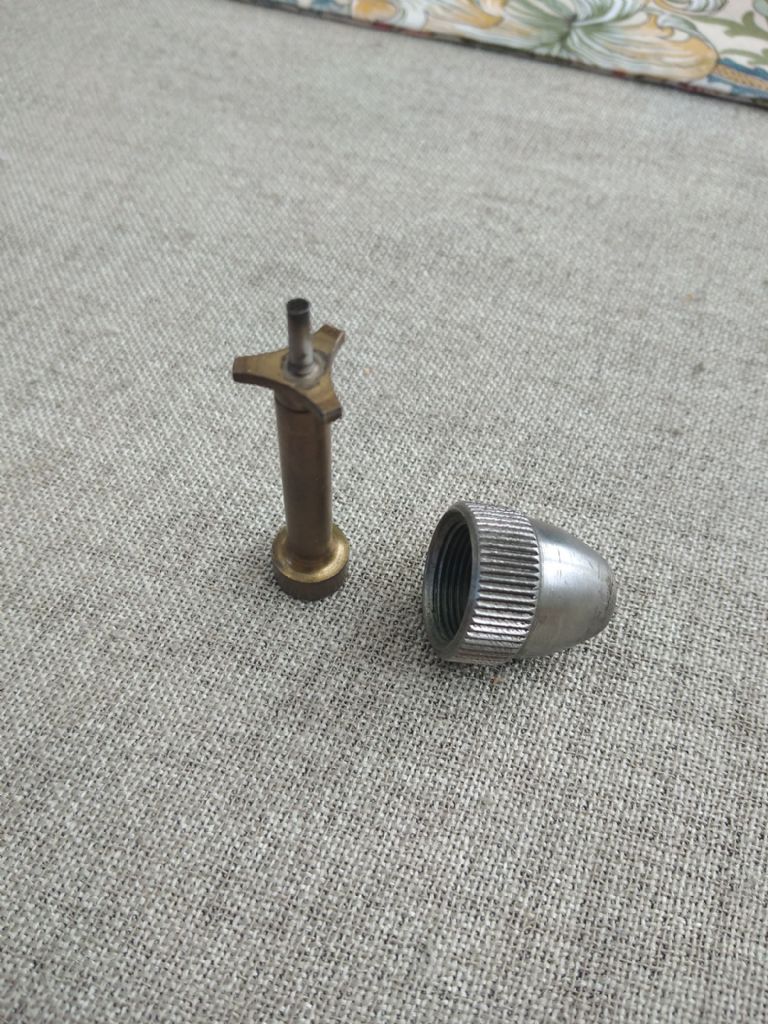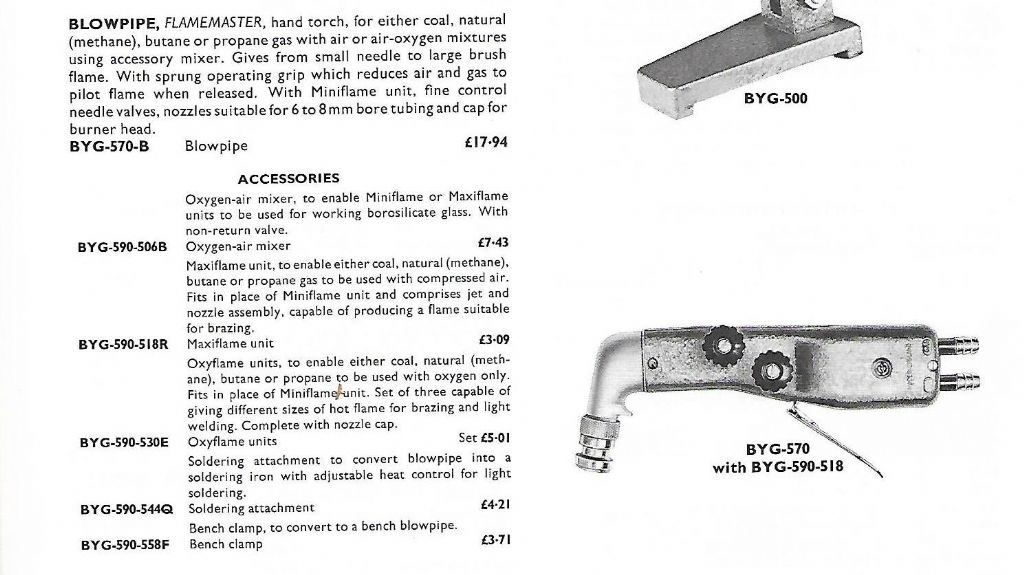Flamemaster Torch
| Ian Stewart 12 | 24/04/2022 07:49:21 |
| 3 forum posts 3 photos | I have acquired a Flamemaster torch MkII which appears identical to ones advertised in ME in the late 1950s thru 1960. It seems to be in mint condition. i wonder if anyone has access to a manual or detailed operating instructions which could be scanned and forwarded please. There are a couple of brief references to this torch in ME 1954 and 1956 and again in the forum a couple of years ago. Thank You Ian Stewart
Edited By JasonB on 24/04/2022 10:04:48 |
| bernard towers | 24/04/2022 13:42:45 |
| 1221 forum posts 161 photos | Photo could be handy. |
| Thor 🇳🇴 | 24/04/2022 14:26:02 |
1766 forum posts 46 photos | Hi Ian, Yes, a photo could be handy as Bernard says, I assume your Flamemaster torch is similar to this? Thor |
| Mark Rand | 24/04/2022 14:42:08 |
| 1505 forum posts 56 photos | If it is, they don't normally get on all that well with gas/air. They were designed for coal/town gas rather than natural gas or propane. Gas/oxygen works better. Either that or a redesigned burner* with flame retention features. * It's on my project list. |
| Bazyle | 24/04/2022 16:50:00 |
6956 forum posts 229 photos | Could be valuable in a few years when they convert the gas main to hydrogen and propane/butane has been outlawed. |
| John Hinkley | 24/04/2022 16:55:34 |
1545 forum posts 484 photos | Posted by Mark Rand on 24/04/2022 14:42:08:
If it is, they don't normally get on all that well with gas/air. They were designed for coal/town gas rather than natural gas or propane. Gas/oxygen works better. Either that or a redesigned burner* with flame retention features. If you look at another ad than the one pointed to by Thor, it states it's suitable for use with butane and compressed air, albeit the "plus" version. Good luck with that. I think I'd get something a little more modern. The clue is in the manufacturer's name! John
|
| V8Eng | 24/04/2022 18:20:21 |
| 1826 forum posts 1 photos | I think you will find that Chance Brothers was a major company in the glass making industry from the early 1800s until they were taken over by Pilkilngtons in the 1950s. Edited By V8Eng on 24/04/2022 18:26:57 |
| V8Eng | 24/04/2022 18:20:22 |
| 1826 forum posts 1 photos | Deleted double post! Edited By V8Eng on 24/04/2022 18:20:56 |
| Mark Rand | 24/04/2022 19:36:19 |
| 1505 forum posts 56 photos | Mine is a MkII Stone-Chance variety. The one in the Labs at work was the more modern version with a flame control ring on the burner. |
| Ian Stewart 12 | 25/04/2022 04:33:29 |
| 3 forum posts 3 photos |
I guess it all comes down to the calorific value of the fuel gases. In Australia our LPG is mostly butane with a variable mix of propane. Reticulated gas is mostly methane. I believe reticulated gas in the UK in the 1950s was derived from coal and had quite a mix of gases. I have a Dillon,( ie/Henrob/Cobra) torch which works very well with LPG and Oxygen, both fed in with less than 4psi. and very low flow rates. |
| Alan Charleston | 25/04/2022 08:04:05 |
| 157 forum posts 26 photos |
I used to use one of these about 50 years ago for glassblowing in a lab. It was normally operated using oxy/natural gas for pyrex glass but I think it was also possible to use air/natural gas for soda glass. It came with three nozzle sizes for different flame sizes. I have an old Gallenkamp catalogue (probably from the 1960s) which shows it. If I've done it right, the entry should show up on this post. Regards, Alan Edited By Alan Charleston on 25/04/2022 08:05:19 |
| Sandgrounder | 25/04/2022 12:09:52 |
| 256 forum posts 6 photos | Posted by John Hinkley on 24/04/2022 16:55:34:
Posted by Mark Rand on 24/04/2022 14:42:08:
If it is, they don't normally get on all that well with gas/air. They were designed for coal/town gas rather than natural gas or propane. Gas/oxygen works better. Either that or a redesigned burner* with flame retention features. If you look at another ad than the one pointed to by Thor, it states it's suitable for use with butane and compressed air, albeit the "plus" version. Good luck with that. I think I'd get something a little more modern. The clue is in the manufacturer's name! John
That's very interesting, I worked at Pilkington for 30 years and have visited two Chance factories, Smethwick and St Asaph and seen plenty of gas torches but never knew Chance made them. John |
| SillyOldDuffer | 25/04/2022 13:08:02 |
| 10668 forum posts 2415 photos | Posted by Ian Stewart 12 on 25/04/2022 04:33:29:
... I guess it all comes down to the calorific value of the fuel gases. I suspect more to do with getting the gas/air mix right. My unmodified bunsen burner stopped working after the UK switched to natural gas. Men did something to the central heating system, cooker and gas fires just before switch over, and they flared off the Town Gas before letting us relight them. I think a wider nozzle is needed to burn Methane, and they may have adjusted the air-intake as well. Town Gas was mostly Hydrogen and Carbon Monoxide, whereas Natural gas is mostly Methane. The ratio of Hydrogen to Oxygen is 1:8, whereas Methane to Oxygen is 1:4, so to burn both a torch would need a wide adjustment range. A torch driven by compressed air might well be OK for that. Dave |
| Bazyle | 25/04/2022 16:45:18 |
6956 forum posts 229 photos | The problem with methane is that it burns more slowly and needs more air relative to the volume of gas. Therefore in an old Bunsen burner the flame will rise up above the end of the tube when you turn the throttle up as it win't burning as fast as the gas was coming out of the tube. As the gas spreads out at the end of the tube it slows down which is why it was able to burn fast enough a little above the end of the tube. The flame is then susceptible to drafts and can blow out. It may just be a case of finding the design of the replaceable brass nozzle bit. |
| Mark Rand | 25/04/2022 20:36:27 |
| 1505 forum posts 56 photos | The nozzles are a very simple design with gas or air being admitted at the centre and air or gas being admitted via an annular hole, with both mixing in the nozzle's tube. I've just checked mine and it appears that the aluminium shroud which retains the nozzle has actually got a small radial clearance between itself and the end of the nozzle. It's probable that the reason for this is to avoid heating the shroud, but it does leave the possibility of drilling a small radial hole into the end portion of the nozzle to allow a leak of mixture to exit via this radial gap. That would act as a flame control ring. I've got too many other pots on the boil at the moment (See what I did there? |
| Ian Stewart 12 | 26/04/2022 02:01:47 |
| 3 forum posts 3 photos | The Flamemaster has a few subtle details. The labels A and B indicate plungers operated by the trigger, A has much greater travel and adds ?fuel while B hardly moves and adds ?air/oxy. The mixing chamber looks remarkably similar to the Dillon. It will be relatively easy to make new orifice pieces to screw into the base piece. The only item which may be damaged is C1 and C2, the screw is obviously a bodge and I am unsure of the details inside C1, it looks as if it is meant to be an adjustment. |
Please login to post a reply.
Want the latest issue of Model Engineer or Model Engineers' Workshop? Use our magazine locator links to find your nearest stockist!
Sign up to our newsletter and get a free digital issue.
You can unsubscribe at anytime. View our privacy policy at www.mortons.co.uk/privacy
- hemingway ball turner
04/07/2025 14:40:26 - *Oct 2023: FORUM MIGRATION TIMELINE*
05/10/2023 07:57:11 - Making ER11 collet chuck
05/10/2023 07:56:24 - What did you do today? 2023
05/10/2023 07:25:01 - Orrery
05/10/2023 06:00:41 - Wera hand-tools
05/10/2023 05:47:07 - New member
05/10/2023 04:40:11 - Problems with external pot on at1 vfd
05/10/2023 00:06:32 - Drain plug
04/10/2023 23:36:17 - digi phase converter for 10 machines.....
04/10/2023 23:13:48 - More Latest Posts...
- View All Topics
- Reeves** - Rebuilt Royal Scot by Martin Evans
by John Broughton
£300.00 - BRITANNIA 5" GAUGE James Perrier
by Jon Seabright 1
£2,500.00 - Drill Grinder - for restoration
by Nigel Graham 2
£0.00 - WARCO WM18 MILLING MACHINE
by Alex Chudley
£1,200.00 - MYFORD SUPER 7 LATHE
by Alex Chudley
£2,000.00 - More "For Sale" Ads...
- D1-3 backplate
by Michael Horley
Price Not Specified - fixed steady for a Colchester bantam mark1 800
by George Jervis
Price Not Specified - lbsc pansy
by JACK SIDEBOTHAM
Price Not Specified - Pratt Burnerd multifit chuck key.
by Tim Riome
Price Not Specified - BANDSAW BLADE WELDER
by HUGH
Price Not Specified - More "Wanted" Ads...
Do you want to contact the Model Engineer and Model Engineers' Workshop team?
You can contact us by phone, mail or email about the magazines including becoming a contributor, submitting reader's letters or making queries about articles. You can also get in touch about this website, advertising or other general issues.
Click THIS LINK for full contact details.
For subscription issues please see THIS LINK.
Model Engineer Magazine
- Percival Marshall
- M.E. History
- LittleLEC
- M.E. Clock
ME Workshop
- An Adcock
- & Shipley
- Horizontal
- Mill
Subscribe Now
- Great savings
- Delivered to your door
Pre-order your copy!
- Delivered to your doorstep!
- Free UK delivery!















 Register
Register Log-in
Log-in


